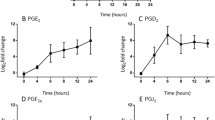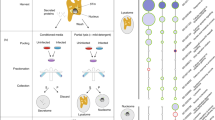Abstract
The endocannabinoids (eCBs) are endogenous arachidonoyl-containing lipid mediators with important roles in host defense. Macrophages are first-line defenders of the innate immune system and biosynthesize large amounts of eCBs when activated. The cellular levels of eCBs are controlled by the activities of their biosynthetic enzymes and catabolic enzymes, which include members of the serine hydrolase (SH) superfamily. The physiologic activity of SHs can be assessed in a class-specific way using chemoproteomic activity-based protein profiling (ABPP) methods. Here, we have examined avian (chicken) HD11 macrophages, a widely used cell line in host–pathogen research, using gel-based ABPP and ABPP-multidimensional protein identification technology (MudPIT) to profile the changes in SH activities under baseline, chemical-inhibitor-treated, and pathogen-challenged conditions. We identified α/β-hydrolase domain 6 (ABHD6) and fatty acid amide hydrolase (FAAH) as the principal SHs responsible for 2-arachidonoylglycerol (2AG) hydrolysis, thereby regulating the concentration of this lipid in HD11 cells. We further discovered that infection of HD11 macrophages by Salmonella Typhimurium caused the activities of these 2AG hydrolases to be downregulated in the host cells. ABHD6 and FAAH were potently inhibited by a variety of small-molecule inhibitors in intact live cells, and thus these compounds might be useful host-directed adjuvants to combat antimicrobial resistance in agriculture. 2AG was further shown to augment the phagocytic function of HD11 macrophages, which suggests that pathogen-induced downregulation of enzymes controlling 2AG hydrolytic activity might be a physiological mechanism to increase 2AG levels, thus enhancing phagocytosis. Together these results define ABHD6 and FAAH as 2AG hydrolases in avian macrophages that can be inactivated pharmacologically and decreased in activity during Salmonella Typhimurium infection.











Similar content being viewed by others
References
Maccarrone M, Finazzi-Agro A (2003) The endocannabinoid system, anandamide and the regulation of mammalian cell apoptosis. Cell Death Differ 10:946–955. https://doi.org/10.1038/sj.cdd.44012844401284
Pacher P, Steffens S (2009) The emerging role of the endocannabinoid system in cardiovascular disease. Semin Immunopathol 31:63–77. https://doi.org/10.1007/s00281-009-0145-8
Howlett AC (2005) Cannabinoid receptor signaling. Handb Exp Pharmacol 2005:53–79
Kozak KR, Crews BC, Ray JL, Tai HH, Morrow JD, Marnett LJ (2001) Metabolism of prostaglandin glycerol esters and prostaglandin ethanolamides in vitro and in vivo. J Biol Chem 276:36993–36998. https://doi.org/10.1074/jbc.M105854200M105854200
Nomura DK, Morrison BE, Blankman JL, Long JZ, Kinsey SG, Marcondes MC, Ward AM, Hahn YK, Lichtman AH, Conti B, Cravatt BF (2011) Endocannabinoid hydrolysis generates brain prostaglandins that promote neuroinflammation. Science 334:809–813. https://doi.org/10.1126/science.1209200
Falasca M, Corda D (1994) Elevated levels and mitogenic activity of lysophosphatidylinositol in k-ras-transformed epithelial cells. Eur J Biochem 221:383–389
Sugiura T, Kondo S, Kishimoto S, Miyashita T, Nakane S, Kodaka T, Suhara Y, Takayama H, Waku K (2000) Evidence that 2-arachidonoylglycerol but not N-palmitoylethanolamine or anandamide is the physiological ligand for the cannabinoid CB2 receptor. Comparison of the agonistic activities of various cannabinoid receptor ligands in HL-60 cells. J Biol Chem 275:605–612
Kobayashi Y, Arai S, Waku K, Sugiura T (2001) Activation by 2-arachidonoylglycerol, an endogenous cannabinoid receptor ligand, of p42/44 mitogen-activated protein kinase in HL-60 cells. J Biochem 129:665–669
Chouinard F, Lefebvre JS, Navarro P, Bouchard L, Ferland C, Lalancette-Hebert M, Marsolais D, Laviolette M, Flamand N (2011) The endocannabinoid 2-arachidonoyl-glycerol activates human neutrophils: critical role of its hydrolysis and de novo leukotriene B4 biosynthesis. J Immunol 186:3188–3196. https://doi.org/10.4049/jimmunol.1002853jimmunol.1002853
Chouinard F, Turcotte C, Guan X, Larose MC, Poirier S, Bouchard L, Provost V, Flamand L, Grandvaux N, Flamand N (2013) 2-Arachidonoyl-glycerol- and arachidonic acid-stimulated neutrophils release antimicrobial effectors against E. coli, S. aureus, HSV-1, and RSV. J Leukoc Biol 93:267–276. https://doi.org/10.1189/jlb.0412200jlb.0412200
Rouzer CA, Marnett LJ (2011) Endocannabinoid oxygenation by cyclooxygenases, lipoxygenases, and cytochromes P450: cross-talk between the eicosanoid and endocannabinoid signaling pathways. Chem Rev 111:5899–5921. https://doi.org/10.1021/cr2002799
Kozak KR, Rowlinson SW, Marnett LJ (2000) Oxygenation of the endocannabinoid, 2-arachidonylglycerol, to glyceryl prostaglandins by cyclooxygenase-2. J Biol Chem 275:33744–33749. https://doi.org/10.1074/jbc.M007088200
Shiratsuchi A, Watanabe I, Yoshida H, Nakanishi Y (2008) Involvement of cannabinoid receptor CB2 in dectin-1-mediated macrophage phagocytosis. Immunol Cell Biol 86:179–184. https://doi.org/10.1038/sj.icb.7100121
Woods J, Lu Q, Ceddia MA, Lowder T (2000) Special feature for the Olympics: effects of exercise on the immune system: exercise-induced modulation of macrophage function. Immunol Cell Biol 78:545–553. https://doi.org/10.1111/j.1440-1711.2000.t01-9-.x
Adams DO, Hamilton TA (1984) The cell biology of macrophage activation. Annu Rev Immunol 2:283–318. https://doi.org/10.1146/annurev.iy.02.040184.001435
Rouzer CA, Marnett LJ (2005) Glycerylprostaglandin synthesis by resident peritoneal macrophages in response to a zymosan stimulus. J Biol Chem 280:26690–26700. https://doi.org/10.1074/jbc.M501021200
Gokoh M, Kishimoto S, Oka S, Sugiura T (2007) 2-Arachidonoylglycerol enhances the phagocytosis of opsonized zymosan by HL-60 cells differentiated into macrophage-like cells. Biol Pharm Bull 30:1199–1205
Serhan CN (2017) Discovery of specialized pro-resolving mediators marks the dawn of resolution physiology and pharmacology. Mol Aspects Med. https://doi.org/10.1016/j.mam.2017.03.001
Buckner MM, Antunes LC, Gill N, Russell SL, Shames SR, Finlay BB (2013) 15-Deoxy-Delta12,14-prostaglandin J2 inhibits macrophage colonization by Salmonella enterica serovar Typhimurium. PLoS ONE 8:e69759
Haraga A, Ohlson MB, Miller SI (2008) Salmonellae interplay with host cells. Nat Rev Microbiol 6:53–66. https://doi.org/10.1038/nrmicro1788
Ibarra JA, Steele-Mortimer O (2009) Salmonella—the ultimate insider. Salmonella virulence factors that modulate intracellular survival. Cell Microbiol 11:1579–1586. https://doi.org/10.1111/j.1462-5822.2009.01368.xCMI1368
Vinson GP (2009) The adrenal cortex and life. Mol Cell Endocrinol 300:2–6
Antunes LC, Arena ET, Menendez A, Han J, Ferreira RB, Buckner MM, Lolic P, Madilao LL, Bohlmann J, Borchers CH, Finlay BB (2011) Impact of salmonella infection on host hormone metabolism revealed by metabolomics. Infect Immun 79:1759–1769. https://doi.org/10.1128/IAI.01373-10IAI.01373-10
Wang Y, Couture OP, Qu L, Uthe JJ, Bearson SM, Kuhar D, Lunney JK, Nettleton D, Dekkers JC, Tuggle CK (2008) Analysis of porcine transcriptional response to Salmonella enterica serovar Choleraesuis suggests novel targets of NFkappaB are activated in the mesenteric lymph node. BMC Genom 9:437. https://doi.org/10.1186/1471-2164-9-4371471-2164-9-437
Shi L, Chowdhury SM, Smallwood HS, Yoon H, Mottaz-Brewer HM, Norbeck AD, McDermott JE, Clauss TR, Heffron F, Smith RD, Adkins JN (2009) Proteomic investigation of the time course responses of RAW 264.7 macrophages to infection with Salmonella enterica. Infect Immun 77:3227–3233
Ziegler S, Pries V, Hedberg C, Waldmann H (2013) Target identification for small bioactive molecules: finding the needle in the haystack. Angew Chem Int Ed Engl 52:2744–2792. https://doi.org/10.1002/anie.201208749
Medina-Cleghorn D, Heslin A, Morris PJ, Mulvihill MM, Nomura DK (2014) Multidimensional profiling platforms reveal metabolic dysregulation caused by organophosphorus pesticides. ACS Chem Biol 9:423–432. https://doi.org/10.1021/cb400796c
Medina-Cleghorn D, Nomura DK (2013) Chemical approaches to study metabolic networks. Pflugers Arch 465:427–440. https://doi.org/10.1007/s00424-012-1201-0
Wang R, Borazjani A, Matthews AT, Mangum LC, Edelmann MJ, Ross MK (2013) Identification of palmitoyl protein thioesterase 1 in human THP1 monocytes and macrophages and characterization of unique biochemical activities for this enzyme. Biochemistry 52:7559–7574. https://doi.org/10.1021/bi401138s
Dinh TP, Kathuria S, Piomelli D (2004) RNA interference suggests a primary role for monoacylglycerol lipase in the degradation of the endocannabinoid 2-arachidonoylglycerol. Mol Pharmacol 66:1260–1264. https://doi.org/10.1124/mol.104.002071mol.104.002071
Blankman JL, Simon GM, Cravatt BF (2007) A comprehensive profile of brain enzymes that hydrolyze the endocannabinoid 2-arachidonoylglycerol. Chem Biol 14:1347–1356. https://doi.org/10.1016/j.chembiol.2007.11.006
Muccioli GG, Xu C, Odah E, Cudaback E, Cisneros JA, Lambert DM, Lopez Rodriguez ML, Bajjalieh S, Stella N (2007) Identification of a novel endocannabinoid-hydrolyzing enzyme expressed by microglial cells. J Neurosci 27:2883–2889. https://doi.org/10.1523/JNEUROSCI.4830-06.2007
Marrs WR, Blankman JL, Horne EA, Thomazeau A, Lin YH, Coy J, Bodor AL, Muccioli GG, Hu SS, Woodruff G, Fung S, Lafourcade M, Alexander JP, Long JZ, Li W, Xu C, Moller T, Mackie K, Manzoni OJ, Cravatt BF, Stella N (2010) The serine hydrolase ABHD6 controls the accumulation and efficacy of 2-AG at cannabinoid receptors. Nat Neurosci 13:951–957. https://doi.org/10.1038/nn.2601nn.2601
Marrs WR, Horne EA, Ortega-Gutierrez S, Cisneros JA, Xu C, Lin YH, Muccioli GG, Lopez-Rodriguez ML, Stella N (2011) Dual inhibition of alpha/beta-hydrolase domain 6 and fatty acid amide hydrolase increases endocannabinoid levels in neurons. J Biol Chem 286:28723–28728. https://doi.org/10.1074/jbc.M110.202853M110.202853
Alhouayek M, Masquelier J, Muccioli GG (2014) Controlling 2-arachidonoylglycerol metabolism as an anti-inflammatory strategy. Drug Discov Today 19:295–304. https://doi.org/10.1016/j.drudis.2013.07.009S1359-6446(13)00243-2
Xie S, Borazjani A, Hatfield MJ, Edwards CC, Potter PM, Ross MK (2010) Inactivation of lipid glyceryl ester metabolism in human THP1 monocytes/macrophages by activated organophosphorus insecticides: role of carboxylesterases 1 and 2. Chem Res Toxicol 23:1890–1904. https://doi.org/10.1021/tx1002194
Hsu KL, Tsuboi K, Adibekian A, Pugh H, Masuda K, Cravatt BF (2012) DAGLbeta inhibition perturbs a lipid network involved in macrophage inflammatory responses. Nat Chem Biol 8:999–1007. https://doi.org/10.1038/nchembio.1105
Alhouayek M, Masquelier J, Cani PD, Lambert DM, Muccioli GG (2013) Implication of the anti-inflammatory bioactive lipid prostaglandin D2-glycerol ester in the control of macrophage activation and inflammation by ABHD6. Proc Natl Acad Sci USA 110:17558–17563. https://doi.org/10.1073/pnas.1314017110
Long JZ, Cravatt BF (2011) The metabolic serine hydrolases and their functions in mammalian physiology and disease. Chem Rev 111:6022–6063. https://doi.org/10.1021/cr200075y
Matthews AT, Lee JH, Borazjani A, Mangum LC, Hou X, Ross MK (2016) Oxyradical stress increases the biosynthesis of 2-arachidonoylglycerol: involvement of NADPH oxidase. Am J Physiol Cell Physiol 311:C960–C974. https://doi.org/10.1152/ajpcell.00251.2015
Kummari E, Alugubelly N, Hsu CY, Dong B, Nanduri B, Edelmann MJ (2015) Activity-based proteomic profiling of deubiquitinating enzymes in Salmonella-infected macrophages leads to identification of putative function of UCH-L5 in inflammasome regulation. PLoS ONE 10:e0135531. https://doi.org/10.1371/journal.pone.0135531
Blankman JL, Cravatt BF (2013) Chemical probes of endocannabinoid metabolism. Pharmacol Rev 65:849–871. https://doi.org/10.1124/pr.112.006387
Crow JA, Bittles V, Borazjani A, Potter PM, Ross MK (2012) Covalent inhibition of recombinant human carboxylesterase 1 and 2 and monoacylglycerol lipase by the carbamates JZL184 and URB597. Biochem Pharmacol 84:1215–1222. https://doi.org/10.1016/j.bcp.2012.08.017
Crow JA, Bittles V, Herring KL, Borazjani A, Potter PM, Ross MK (2012) Inhibition of recombinant human carboxylesterase 1 and 2 and monoacylglycerol lipase by chlorpyrifos oxon, paraoxon and methyl paraoxon. Toxicol Appl Pharmacol 258:145–150. https://doi.org/10.1016/j.taap.2011.10.017
Rea D, Fulop V (2011) Prolyl oligopeptidase structure and dynamics. CNS Neurol Disord Drug Targets 10:306–310
Szafran B, Borazjani A, Lee JH, Ross MK, Kaplan BL (2015) Lipopolysaccharide suppresses carboxylesterase 2 g activity and 2-arachidonoylglycerol hydrolysis: a possible mechanism to regulate inflammation. Prostaglandins Other Lipid Mediat 121:199–206. https://doi.org/10.1016/j.prostaglandins.2015.09.005
Pacher P, Mechoulam R (2011) Is lipid signaling through cannabinoid 2 receptors part of a protective system? Prog Lipid Res 50:193–211. https://doi.org/10.1016/j.plipres.2011.01.001
Acknowledgements
This work was supported by the Mississippi Center for Food Safety and Post-harvest Technology Grant Program (USDA-ARS; SCA Food Safety 500-00031-001-00D) and by indirect funds from the National Institutes of Health 1R15ES015348-02.
Author information
Authors and Affiliations
Corresponding author
Ethics declarations
Conflict of interest
The authors declare that they have no conflict of interest.
Electronic supplementary material
Below is the link to the electronic supplementary material.
Rights and permissions
About this article
Cite this article
Lee, J.H., Hou, X., Kummari, E. et al. Endocannabinoid hydrolases in avian HD11 macrophages identified by chemoproteomics: inactivation by small-molecule inhibitors and pathogen-induced downregulation of their activity. Mol Cell Biochem 444, 125–141 (2018). https://doi.org/10.1007/s11010-017-3237-0
Received:
Accepted:
Published:
Issue Date:
DOI: https://doi.org/10.1007/s11010-017-3237-0




